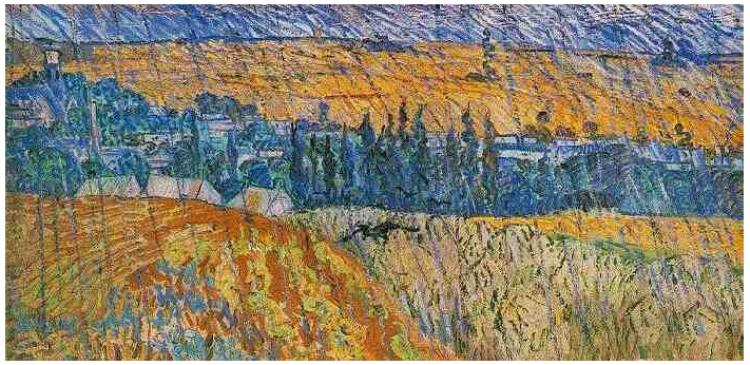Vincent van Gogh and Nature
 Monday, September 14, 2015 at 07:02PM
Monday, September 14, 2015 at 07:02PM 50 Paintings and Drawings at the Clark Museum
Williamstown, Massachusetts
In the web of nature, where van Gogh created his masterpieces, he was transfixed by all that is alive: rocks, water, trees, humanity. He was able to portray life supernaturally with brush and paint. He wrote, "[i]f one draws a pollard willow as if it were a living being, which after all it is, then the surroundings follow almost by themselves, provided only that one has focused all one's attention on that particular tree and not rested until there [is] some life in it." 1
A sweet euphoria slowly swept through me as I walked through the van Gogh exhibit at the Clark Museum. I had never been there before and it is a stunning facility. The museum is on an exceptional site, green rolling hills frame the contemporary architecture of the building. Cows graze in open pasture behind it just beyond an infinity water pool, where visitors can sit and take it all in. With the natural beauty of this place in the Berkshires in mind, Richard Kendall, Chris Stolwijk and Sjaar van Heugten curated a superb exhibit. Included are paintings and drawings on loan from many noted collections -the Van Gogh Museum, Amsterdam; the Kröller-Müller Museum, Otterlo, the Netherlands; the Museé d’Orsay, Paris; the National Gallery, London; The Metropolitan Museum, New York; and the Museum of Modern Art, New York.
As we entered the first room of the exhibit I was drawn into several works on paper. I wish I could hold them all in my mind's eye now, it is a fleeting joy. Although a bit dark in the first room and somewhat problematic to see the work because of that, (dimly lit to protect the delicate works on paper), as we moved through the rooms each piece opened my irises further to the light within the work. Vincent was so present there, hovering around us.
His work impresses upon me the Artisan- Priest- Minister that he was and how much of that energy he communicated, his shamanistic side, in the artwork he created. Van Gogh wrote about his "awareness that art is something greater and higher than our own skill or knowledge or learning...art is something which, though produced by human hands, is not wrought by hands alone, but wells up from a deeper source, from man's soul..." 2 It is difficult to separate the paintings from the artist, the tragic circumstances of his struggle to survive mentally, physically and emotionally. Yet there is a revery that he conveyed painting a vase of flowers; a portrait; in the Dutch landscape; in an interior space which holds so much vibration that the work pulses. Everything is alive and breathing in his later paintings.
In the second room there was a Monet painting that van Gogh had seen in person. It was beautiful, of course, in a gilded frame as we are accustomed to seeing from that era. At the moment I was observing it, on the top edge of the frame, mid-point, sat a live fly, ever so still as if it had just emerged from the field in the painting. As I read now the detailed letters that Vincent wrote to his brother Theo, I am reminded of this fly on the frame as well as one of the final paintings he made just before he died of what may or may not have been a self-inflicted wound. Landscape at Auvers in the Rain, is the concluding painting in the exhibit. Years before he wrote to Theo about witnessing a rainstorm:
“Did I write to you about the storm I watched not long ago? The sea was yellowish, especially close to the shore. On the horizon a streak of light and above it immensely large dark grey clouds, from which one could see the rain coming down in slanting streaks.”3
In the exhibit, just to the right of the painting, a small Japanese print was included that may have inspired the painting or perhaps it was the earlier experience in Ramsgate, England that he wrote about to Theo. I was touched by his courage as a painter to put in the slanted lines indicating rain. It was a risk, a risk that worked. Streaked with sadness, it moved me to tears. I could sense that the gallery guard standing next to the painting saw my emotional response, as I viewed Landscape at Auvers in the Rain, and I wondered how many other visitors to the show he had witnessed react in a similar way? If I were a fly on the wall watching, I imagine, there were many. Van Gogh said, "surely, the true path is to delve deep into nature." 4 Surely, he did.
In Rain–Auvers (1890, National Museum of Wales, Cardiff), - See more at: http://clarkart.edu/About/Press-Room/Press-Releases/2015/Van-Gogh#sthash.XTBJNcR5.dpuf
1,2,3,4 from The Letters of Vincent van Gogh
Reader Comments